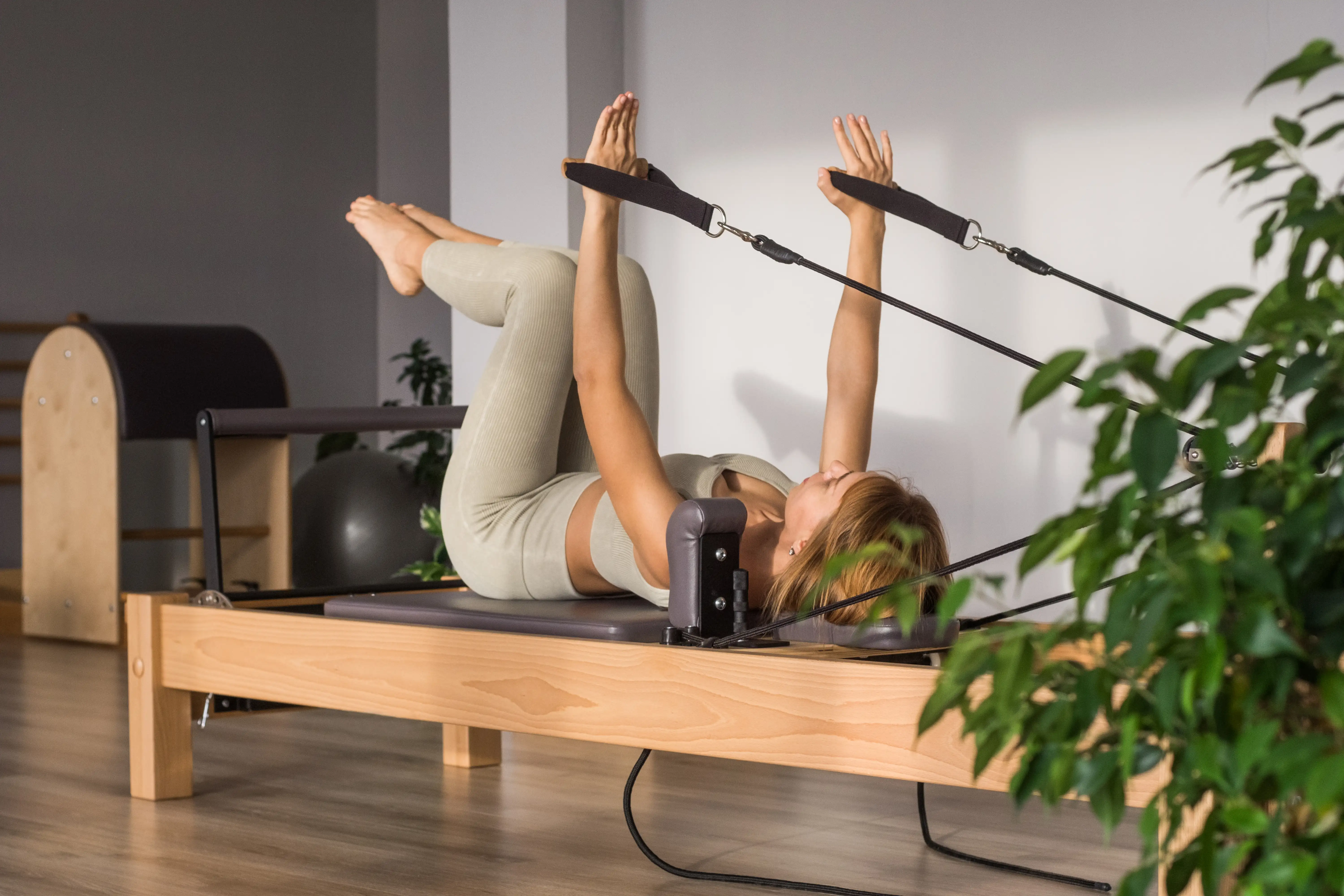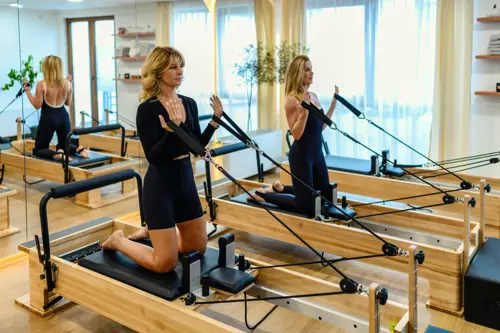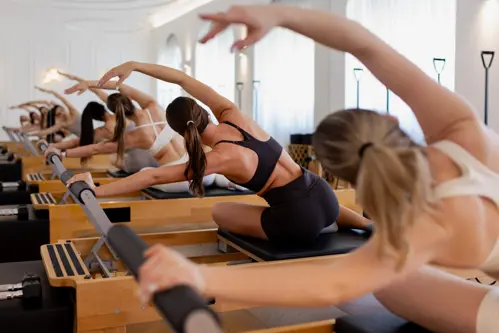What are the benefits of reformer Pilates?
28 November 2025

Reformer Pilates sessions are gaining popularity due to the numerous benefits they offer. From improving mobility and boosting core strength to full-body toning and enhancing coordination, reformer Pilates is an excellent addition to any fitness plan.
In this guide, we discuss what reformer Pilates is, how to use a reformer, the benefits, and some tips for staying safe during your workout.
What is reformer Pilates?

Reformer Pilates is a style of Pilates performed on a machine called the reformer. This piece of equipment uses springs, pulleys, a moving carriage, and adjustable resistance to strengthen, lengthen, and align the body. Reformer Pilates is one of the most effective forms of Pilates as the machine adds resistance and support, allowing for a huge variety of full-body exercises.
The reformer itself is a long, flat platform that rolls backwards and forwards on rails. It features springs that add and reduce resistance, straps and pulleys for arm and leg movements, shoulder blocks, and a foot bar for stability, as well as adjustable settings to accommodate different fitness levels. The reformer has been designed to enable smooth, controlled resistance throughout each movement.
Reformer Pilates focuses on core strength, posture, alignment, flexibility, mobility, balance, coordination, and full-body toning. As the springs provide both assistance and resistance, they are kind to joints while being extremely challenging. This increasingly popular form of Pilates is suitable for beginners, athletes, individuals with back or joint issues, and anyone seeking to incorporate low-impact, full-body strength training into their routine.
People love reformer Pilates because it delivers fast results, improves posture, strengthens muscles, and makes the body feel more balanced and toned.
How to use a reformer
Using a reformer for the first time can feel daunting, but once you understand the different parts and basic movements, you’ll find your confidence grows in no time.
Understand the different parts
Before using a reformer, it’s important to get an understanding of the machine. The main parts include:
- Carriage – The platform that slides back and forth
- Foot bar – Where your feet or hands press to move the carriage
- Springs – Add or remove resistance
- Shoulder blocks – Keep you stable when lying down
- Headrest – Supports your head and neck
- Straps – For arm and leg work
- Gear settings – Adjust strap length and tension
Set your springs correctly
Springs control the resistance of the exercise, with more springs making the reformer feel heavier and more stable, and fewer springs making the machine feel lighter and less stable, requiring more intense core work.
Beginners usually start with medium to heavy springs for safety and then progress from there as their confidence grows.
Start with basic movements
Begin with safe, core-focused movements and ensure you’re comfortable with these before progressing to more challenging moves.
- Footwork – Lie on your back with your feet on the foot bar and press the carriage out. This move is excellent for learning alignment and getting comfortable with the reformer.
- Leg circles – With straps on your feet, draw circles in the air. These leg circles help to build hip mobility and core stability.
- Bridging – Put your feet on the foot bar, lift your hips and articulate your spine. This bridge movement will strengthen your glutes and lower back over time.
- Arms in straps – While kneeling or lying down, pull the straps to work your shoulders, core, and upper body.
Move slowly with control
The reformer works best when you use smooth, fluid movements, engage your core, control your breathing, and avoid letting the carriage hit the stopper at speed. You should maintain a neutral spine position whenever possible, as this will help protect your back and ensure your form is correct.
Listen to your instructor
If you’re in a reformer Pilates class, let your Pilates instructor know you’re new to the exercise, ask them for help with adjusting springs where required, and listen to them carefully throughout the session. Reformer Pilates is very form-specific, so guidance from a knowledgeable instructor really helps, especially when you’re getting used to it.
Progress gradually
As you become more comfortable and confident using the reformer, try lighter spring settings to challenge your balance. Experiment with different kneeling, seated, and standing movements, and combine strap and foot bar exercises for a full-body workout.
Reformer Pilates benefits

Reformer Pilates boasts lots of great benefits, which is the main reason it’s steadily rising in popularity. Some of the top benefits of this workout include:
1. Improved core strength and stability
By targeting the abdominal muscles, obliques, and lower back, it strengthens the core, thereby improving posture, balance, and overall movement.
2. Full-body muscle toning
The reformer uses springs, straps, and body weight to work all major muscle groups, building long, lean muscles without making you appear bulky.
3. Improved flexibility and mobility
The smooth, controlled movements performed in reformer Pilates lengthen and strengthen muscles. This also helps to open tight hips and shoulders, resulting in an increased range of motion.
4. Posture and alignment
Reformer Pilates teaches body awareness and spinal alignment, which reduces slouching and back discomfort.
5. Low impact and joint-friendly
The reformer’s springs provide adjustable resistance, reducing stress on joints. This makes it suitable for beginners, older adults, and those recovering from injury.
6. Balance and coordination
Reformer Pilates requires precision, focus, and controlled breathing. These combine to enhance body awareness, coordination, and movement efficiency.
7. Aesthetic benefits
This form of Pilates tones and sculpts the body evenly while strengthening stabilising muscles used in everyday activities and sports.
Staying safe in reformer Pilates
- Keep hands and feet clear of the rails while the reformer is in use
- Don’t add or remove springs while the carriage is moving
- Start slowly and build movements up as you gain confidence
- Stop if something feels painful or unstable
Reformer Pilates FAQs

How often should you practice reformer Pilates each week?
This depends on your personal goals, fitness level, and recovery requirements. Attending two to four sessions per week can help you achieve results. It’s best to start with one or two sessions and increase this as your stability and endurance improve. You can technically do reformer Pilates every day, but it's recommended to take rest days in between sessions to prevent fatigue or injury.
Is reformer Pilates actually effective?
Reformer Pilates can be highly effective, depending on your goals. This form of exercise is particularly beneficial for individuals seeking to enhance their core strength, stability, and posture, and can also aid in improving mobility and flexibility. However, it’s not the best choice for those looking for a weightlifting or cardio-based workout. Integrating it into your regular workout routine can help you achieve a broader range of results.
How long does it take to see results from reformer Pilates?
You can start seeing noticeable results in about four to eight weeks, depending on how often you train and what your goals are. Within the first few weeks, you can expect to notice improvements in posture, enhanced coordination, and reduced stiffness. By week six, you may have a more toned mid-section, stronger glutes, and more shoulder and arm definition. After 12 weeks of consistent workouts, you’ll notice improvements in strength, endurance, posture, and muscle tone.
Is reformer Pilates good for belly fat?
Reformer Pilates can help to reduce belly fat, but perhaps not in the way you’d expect. For example, it will strengthen your core, which can make your belly look flatter, improve your posture, which results in a slimmer appearance, and increase muscle engagement, which can boost calorie burn throughout the day. Combining reformer Pilates with walking or light cardio, strength training, and balanced nutrition is the best way to achieve a flatter stomach.
Specialist Pilates insurance through Insure4Sport
Whether you’re experienced or entirely new to Pilates, you may want to consider getting specialist Pilates insurance to help provide financial protection should you injure yourself or a third party.
Learn more about specialist Pilates insurance through Insure4Sport or get a quick quote today.
Please note the information provided on this page should not be taken as advice and has been written as a matter of opinion. For more on insurance cover and policy wording, see our homepage.
Got a question? Call our UK call centre 0800 158 5530
©Copyright Ripe Thinking Limited 2025.
Insure4Sport® is a registered trademark and a trading name of Ripe Insurance Services Limited which is Authorised and Regulated by the Financial Conduct Authority No.313411. Registered office: The Royals, Altrincham Road, Manchester M22 4BJ. Registered in England No. 04507332.
